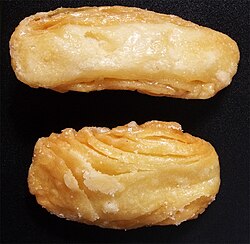Khaja
 | |
| Place of origin | India & Nepal |
|---|---|
| Region or state | Bihar, Uttar Pradesh, Odisha, Kakinada in Andhra Pradesh,Southern area of Nepal (Birgunj, Janakpur, Biratnagar) |
| Main ingredients | Wheat flour, sugar, Cooking oil |
| Variations | Kakinada khaja, Tapeswaram Khaja, Pipra। Pipra Khaja |
Khaja is an Indian deep-fried pastry, commonly filled with fruit or soaked with sugar syrup.
History[edit]
Khajjaka, plain or sweet mentioned in Manasollasa, was a wheat flour preparation fried in ghee.[1] Khaja is believed to have originated from the eastern parts of the former state of Oudh and the former United Provinces of Agra and Oudh. This area presently corresponds to eastern districts of Uttar Pradesh and Western districts of Bihar.[2] and is also native to state of Odisha[3][4] as well as regions like Kutch and Andhra Pradesh. Refined wheat flour with sugar is made into layered dough, with or without dry fruit or other stuffing, and lightly fried in oil to make khaja.[5] It is one of the famous sweets of Odisha and is related to emotions of all Odia people. It is also offered as an offering in the Jagannath Temple, Puri.[4]
Khajas from Silao and Rajgir in Bihar are almost entirely similar to baklava, whereas the ones from Odisha and Andhra Pradesh are made with thicker pastry sheets, and are generally hard.[5][6] The batter is prepared from wheat flour, mawa and oil. It is then deep fried until crisp, before being soaked in a sugar syrup known as Paga, the pastry absorbing the syrup. Khaja served in of Kakinada, a coastal town of Andhra Pradesh, are served dry on the outside and soaked with sugar syrup on the inside.
Khaja Mithai in Nepal are popular in the Maithali and Bhojpuri communities. This sweet is part of chhat puja celebrations in Nepal.
See also[edit]
References[edit]
- ↑ "Full text of "Indian Food Tradition A Historical Companion Achaya K. T."". archive.org. Retrieved 2019-01-30.
- ↑ "Centuries old Khaja sweets, the popular mouthwatering delicacy of Bihar". 10 February 2008.
- ↑ Gopinath Mohanty; Jeeban Kumar Patnaik; Santosha Kumāra Ratha (2002). Cultural heritage of [Orissa]. State Level Vyasakabi Fakir Mohan Smruti Samsad.
- ↑ 4.0 4.1 Orissa Review. Home Department, Government of Orissa. 1990.
- ↑ 5.0 5.1 Elizabeth Fernandez, Sugar and spice and all things nice, ISBN 978-1409287223
- ↑ Chitrita Banerji, Eating India: An Odyssey into the Food and Culture of the Land of Spices, ISBN 978-1596910188